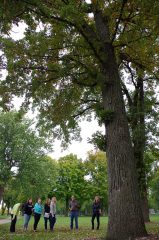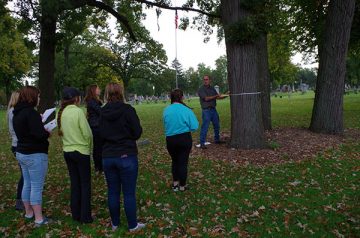 When passing by a tree in Oshkosh, many do not give it a second thought.
When passing by a tree in Oshkosh, many do not give it a second thought.
The students in assistant professor Ed Miller’s University Studies Program (USP) Quest III urban planning class, however, are learning to look at trees from a different perspective. After a semester of study, a group of University of Wisconsin Oshkosh students now call some of these big, old trees seen throughout the city “heritage trees.”
Through their general education class at UW Oshkosh, the students had an opportunity to work on a project with the city forester and a city planner at Riverside Cemetery.
Each semester, UW Oshkosh’s nationally-regarded USP sends hundreds of students into the community as part of their studies. Faculty members teaching Quest III courses within the USP connect classroom content with community entities and agencies, which gives students high-impact learning opportunities well beyond the conventional classroom walls.
“Heritage trees are trees that have unique value due to their size, species, location, structural form or historical significance,” said Bill Strum, the Oshkosh city forester for the last 12.5 years. “A heritage tree program seeks to protect trees that have significant value to a community and ensure that comprehensive management of these trees will protect them from injury due to future construction or poor maintenance practices.”
Through the opportunity to work in the field through their Quest III class, UW Oshkosh students learned the importance of conservation and sustainable practices concerning these trees and the history they hold.
“The field day provided students with access to a site that is on the National Register of Historic Places and includes some trees that could potentially be considered Heritage Trees. Students were shown what to look for as potential nominating features and take baseline data of the size, species, vitality and location of individual trees or collections of trees,” Strum said.
 The students are now working on a heritage tree program for the city themselves. They are developing a policy and nomination form that could be used as an outline for a future municipal program.
The students are now working on a heritage tree program for the city themselves. They are developing a policy and nomination form that could be used as an outline for a future municipal program.
“We are helping to make a heritage/historical tree program to protect old, rare or historically important trees,” said Miranda Shanks, a sophomore majoring in natural broadfield science education. “We have researched other programs and are trying to make a form that can be submitted to protect trees that the Oshkosh community would like to protect.”
Strum hopes that the students viewed this sustainability-focused project as a fun learning opportunity.
“I really enjoyed working alongside the Quest III students throughout the duration of the project. I hope that we provided valuable insight into what it takes to develop a heritage tree program or other similar public policy.”
The students not only gained experience with public policy from their project, but the experience opened their eyes to the importance of preserving nature.
“This gets people outside looking to preserve nature,” Shanks said. “It helps Oshkosh by keeping it beautiful while also promoting tourism of historic trees and making sure Oshkosh receives any help it needs to protect these trees and our limited past.”
Learn more:

